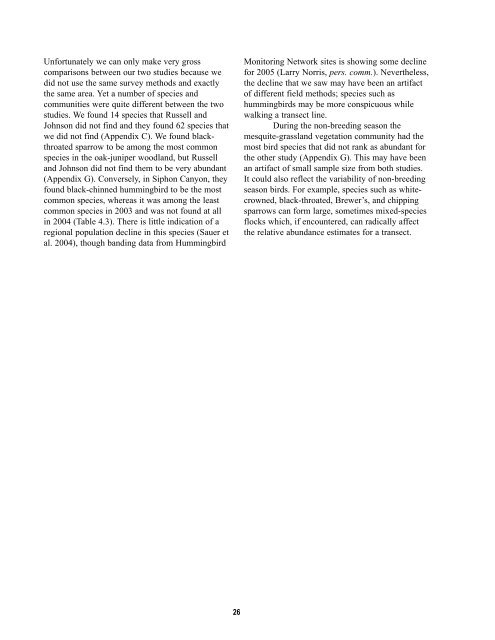Download this report as a 94-page PDF - USGS
Download this report as a 94-page PDF - USGS
Download this report as a 94-page PDF - USGS
You also want an ePaper? Increase the reach of your titles
YUMPU automatically turns print PDFs into web optimized ePapers that Google loves.
Unfortunately we can only make very gross<br />
comparisons between our two studies because we<br />
did not use the same survey methods and exactly<br />
the same area. Yet a number of species and<br />
communities were quite different between the two<br />
studies. We found 14 species that Russell and<br />
Johnson did not find and they found 62 species that<br />
we did not find (Appendix C). We found blackthroated<br />
sparrow to be among the most common<br />
species in the oak-juniper woodland, but Russell<br />
and Johnson did not find them to be very abundant<br />
(Appendix G). Conversely, in Siphon Canyon, they<br />
found black-chinned hummingbird to be the most<br />
common species, where<strong>as</strong> it w<strong>as</strong> among the le<strong>as</strong>t<br />
common species in 2003 and w<strong>as</strong> not found at all<br />
in 2004 (Table 4.3). There is little indication of a<br />
regional population decline in <strong>this</strong> species (Sauer et<br />
al. 2004), though banding data from Hummingbird<br />
26<br />
Monitoring Network sites is showing some decline<br />
for 2005 (Larry Norris, pers. comm.). Nevertheless,<br />
the decline that we saw may have been an artifact<br />
of different field methods; species such <strong>as</strong><br />
hummingbirds may be more conspicuous while<br />
walking a transect line.<br />
During the non-breeding se<strong>as</strong>on the<br />
mesquite-gr<strong>as</strong>sland vegetation community had the<br />
most bird species that did not rank <strong>as</strong> abundant for<br />
the other study (Appendix G). This may have been<br />
an artifact of small sample size from both studies.<br />
It could also reflect the variability of non-breeding<br />
se<strong>as</strong>on birds. For example, species such <strong>as</strong> whitecrowned,<br />
black-throated, Brewer’s, and chipping<br />
sparrows can form large, sometimes mixed-species<br />
flocks which, if encountered, can radically affect<br />
the relative abundance estimates for a transect.

















